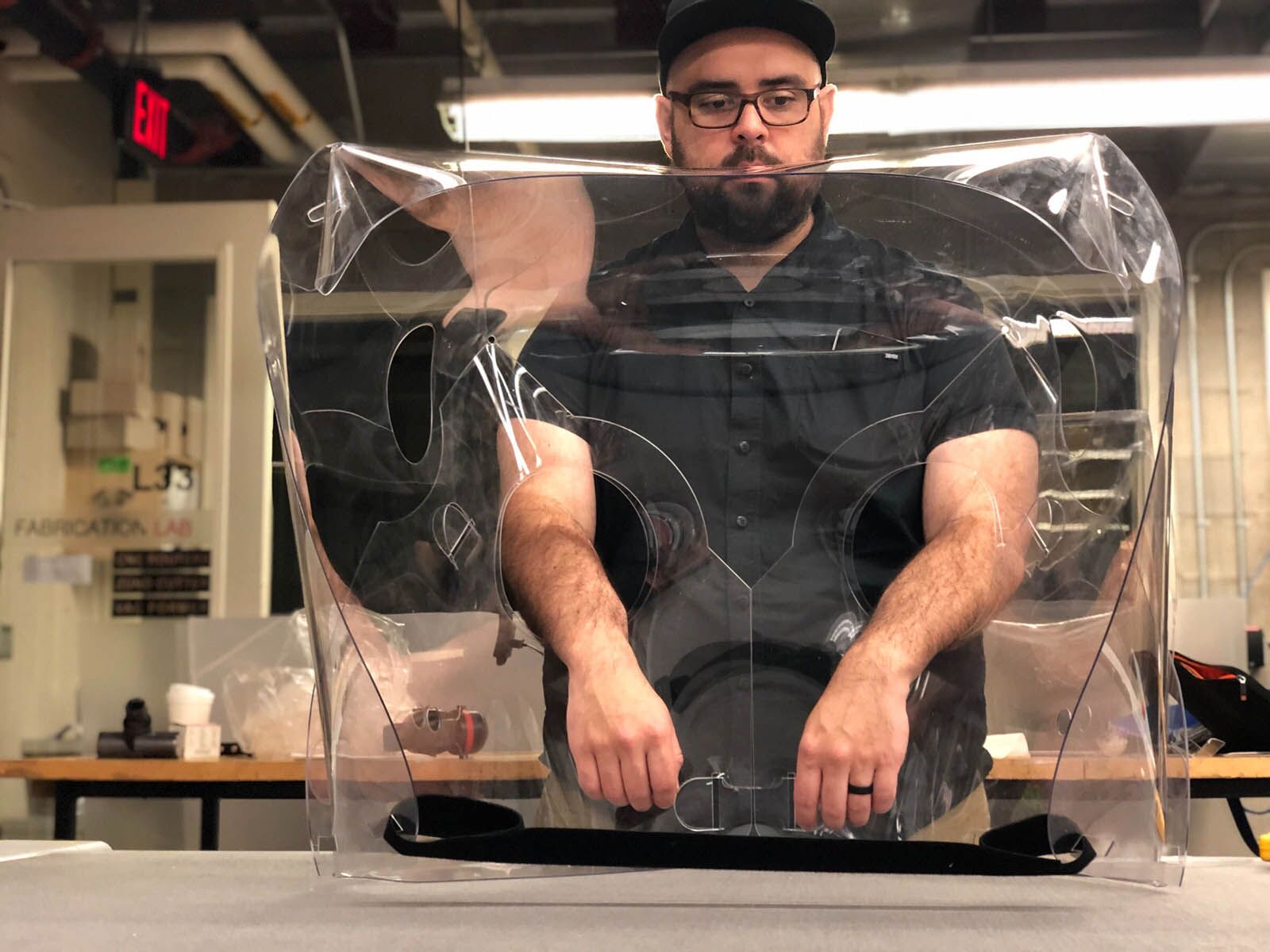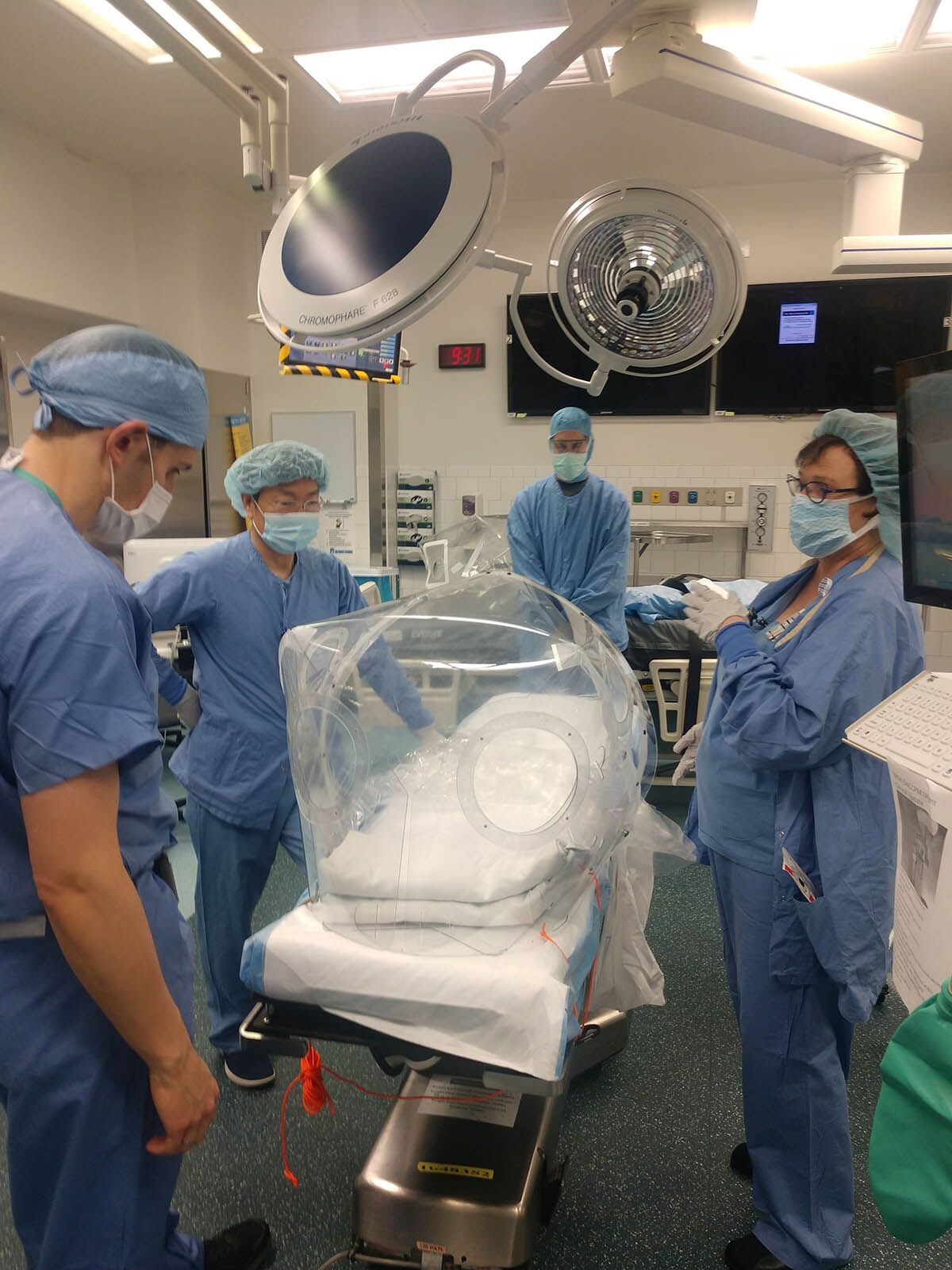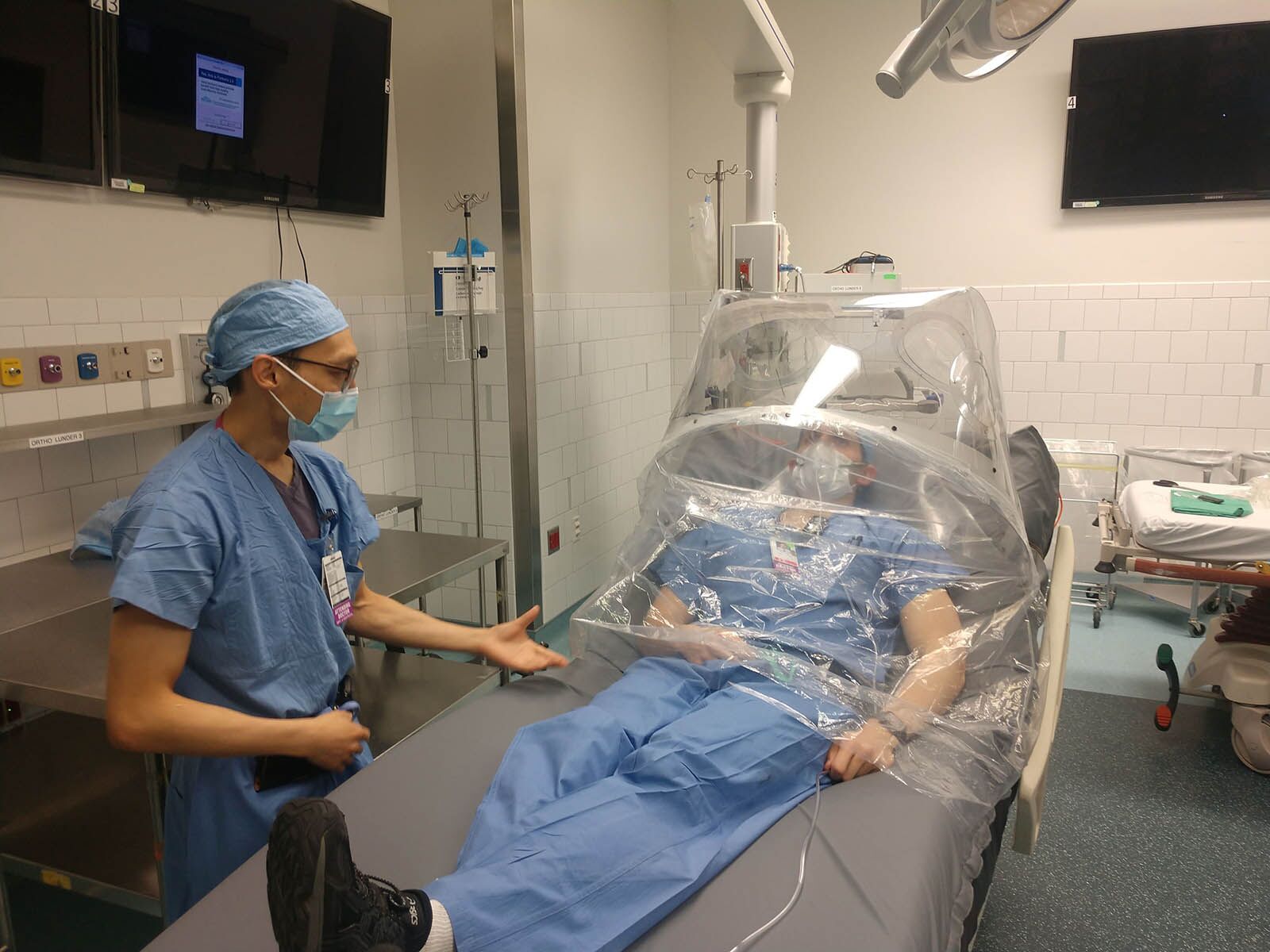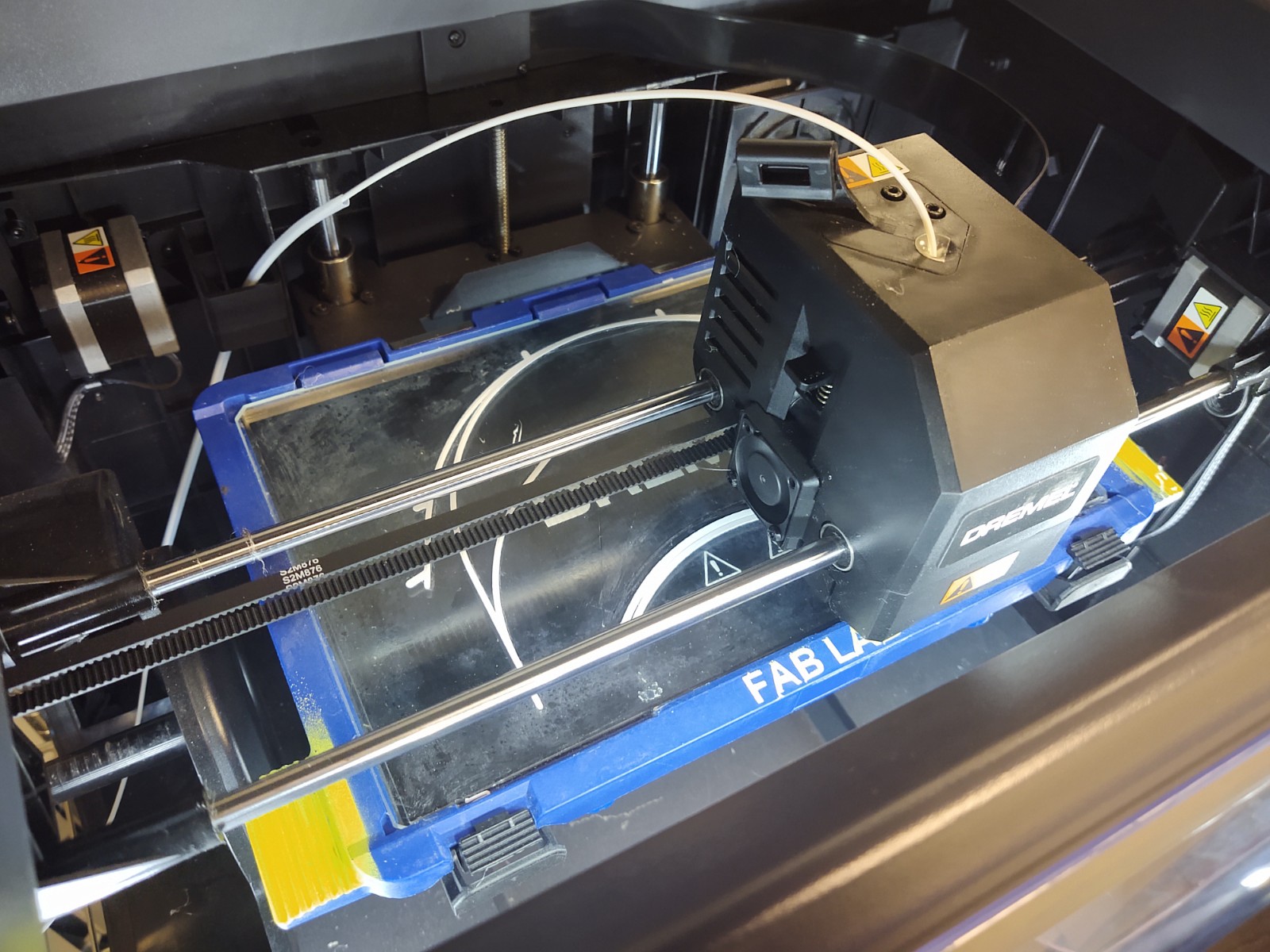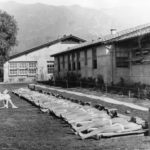Amid the COVID-19 global pandemic, the Harvard Graduate School of Design community is working to leverage its skills and resources to contribute to response efforts. This website provides a centralized resource page for updates from across the GSD: news from the Fabrication Laboratory on production of Personal Protective Equipment (PPE) and other gear, relevant essays by leading design academics, remembrances of those we’ve lost, and other news from the GSD network.
News on Production of Medical Equipment
April 22, 2020: Face shield and Patient Isolation Hood (PIH) updates
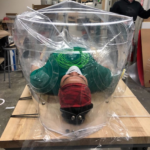
The Fabrication Lab has 3D printed 948 mounts/visor and laser cut 914 shields. As materials are replenished, staff will continue making gear in collaboration with what is requested by medical personnel.
Four Patient Isolation Hood (PIH) prototypes have been completed by a team led by GSD and Harvard colleagues working in the GSD’s Fabrication Lab. Three will be delivered to Massachusetts General Hospital and one will go to Boston Children’s Hospital for review.
April 15, 2020: GSD begins patient isolation hood (PIH) design and fabrication alongside ongoing PPE efforts
The GSD’s Digital Fabrication Specialist Chris Hansen has collaborated with an array of Harvard and GSD colleagues to design two PIH prototypes, fabricating them on April 13 and delivering them to Massachusetts General Hospital (MGH) on April 14. Hansen and colleagues spent much of April 15 on continued design and prototyping; by the end of this week, the GSD aims to have produced between 20 and 30 PIHs for a trial run in MGH’s intensive care unit. Read more.
April 7, 2020: GSD begins producing personal protective equipment (PPE) for Boston-area hospitals
With a stable of 3-D printers, other state-of-the-art fabrication technologies, and expert guidance from across Harvard University, the Harvard Graduate School of Design has begun production of personal protective equipment, or PPE, for front-line medical personnel at area hospitals. GSD fabrication began on April 5, and on April 6, the school delivered a first run of 90 face shields to Brigham and Women’s Hospital (BWH) and set up over one hundred 3-D printers in the school’s Gund Hall for continued production. Read more.
March 26, 2020: GSD’s Fabrication Lab facilities being considered for possible production of medical supplies
 GSD Assistant Dean for Information Technology Stephen Ervin and 3-D Fabrication Specialist Chris Hansen have been in consultation with the newly formed Mass General Brigham (MGB) Center for COVID Innovation to explore whether and how the GSD’s Fabrication Lab facilities, including 3-D printers, might be put to work to address critical shortages in Personal Protective Equipment (PPE) for front-line medical personnel—PPE such as face masks, and diagnostic aids such as nasopharyngeal test swabs. Together with the GSD’s Martin Bechthold, Kumagai Professor of Architectural Technology and Director of the Doctor of Design Studies and Master in Design Engineering programs, Ervin and Hansen are coordinating with other Harvard partners. Read more.
GSD Assistant Dean for Information Technology Stephen Ervin and 3-D Fabrication Specialist Chris Hansen have been in consultation with the newly formed Mass General Brigham (MGB) Center for COVID Innovation to explore whether and how the GSD’s Fabrication Lab facilities, including 3-D printers, might be put to work to address critical shortages in Personal Protective Equipment (PPE) for front-line medical personnel—PPE such as face masks, and diagnostic aids such as nasopharyngeal test swabs. Together with the GSD’s Martin Bechthold, Kumagai Professor of Architectural Technology and Director of the Doctor of Design Studies and Master in Design Engineering programs, Ervin and Hansen are coordinating with other Harvard partners. Read more.
Essays from GSD Scholars
Jeffrey Schnapp on the spatial logic of quarantine: “When the world is again unparked, will it know how to unplug?”
“Being grounded has a way of regrounding people’s values and I am persuaded that shelter-in-place policies are fostering a new hyperlocalism—a rerooting in situ that is likely to continue to favor walkable and bikeable mobility over long-distance displacements.” Jeffrey Schnapp holds the Carl A. Pescosolido Chair in Italian and Comparative Literature in the Faculty of Arts and Sciences and is also affiliated with the Department of Architecture at Harvard’s Graduate School of Design. Read more.
Resources for a just recovery from the GSD’s CoDesign Field Lab
“The coronavirus outbreak has both revealed and exacerbated structural inequities in American cities. Challenges faced by low- and moderate-income communities have escalated during the pandemic, with respect to housing insecurity, precarious work arrangements, lack of access to healthcare and affordable childcare, and a shortage of safe and healthy recreational spaces.” This post was written in the context of the Harvard Graduate School of Design’s project-based research seminar “CoDesign Field Lab: Program Evaluation for Change Leadership” (Spring 2020). Read more.
A radical transformation in building and designing for health is underway—but not everyone will benefit equally
GSD faculty including Malkit Shoshan, Rahul Mehrotra, Stephen Gray, Martha Schwartz, Michael Hooper, and Chris Reed examine the positive and negative implications of designing for health, particularly for marginalized and oppressed communities. Read more.
The pandemic has caused an unprecedented reckoning with digital culture. Architecture may never be the same again (and why that’s okay)
 Reflections on creating architectural culture online during the pandemic, based on interviews with members of the GSD community: Jeanne Gang, Antoine Picon, Jose Luis García del Castillo y López, Michelle Chang, Ana Miljački, Lisa Haber-Thomson, and Dan Sullivan. Read more.
Reflections on creating architectural culture online during the pandemic, based on interviews with members of the GSD community: Jeanne Gang, Antoine Picon, Jose Luis García del Castillo y López, Michelle Chang, Ana Miljački, Lisa Haber-Thomson, and Dan Sullivan. Read more.
Pandemics and the future of urban density: Michael Hooper on hygiene, public perception and the “urban penalty”
“Prior to the pandemic, I was intrigued by the relative lack of empirical, contemporary research on the relationship between hygiene and attitudes toward density. This gap was particularly interesting because there is a substantial body of fascinating tangential evidence that suggests people’s attitudes to urban density might be influenced by hygiene concerns.” Michael Hooper is Associate Professor of Urban Planning. Read more.
How to mitigate the impact of an epidemic and prevent the spread of the next viral disease: A guide for designers
 “Designers play an essential role in the prevention, control, and response of many of these diseases, so getting involved is not a matter of a choice anymore, but a duty.” Dr. Elvis Garcia is an expert in epidemics and a lecturer in the Department of Architecture. Read more.
“Designers play an essential role in the prevention, control, and response of many of these diseases, so getting involved is not a matter of a choice anymore, but a duty.” Dr. Elvis Garcia is an expert in epidemics and a lecturer in the Department of Architecture. Read more.
What role do planning and design play in a pandemic? Ann Forsyth reflects on COVID-19’s impact on the future of urban life

“For the past decades, those looking at the intersections of planning, design, and public health have focused less on infectious diseases and more on chronic disease, hazards and disasters, and the vulnerable. The current pandemic brings the question of designing for infectious diseases back to the forefront and raises important questions for future research and practice.” Ann Forsyth is Ruth and Frank Stanton Professor of Urban Planning. Read more.
In Memoriam
Michael McKinnell (1935-2020); Professor and Boston City Hall architect

Michael McKinnell, a fixture at the Harvard Graduate School of Design and in the architectural canon, died on March 27 at the age of 84 from COVID-19-induced pneumonia. He is survived by his wife, Stephanie Mallis (MArch ’78), and two daughters. As co-founder of Kallmann, McKinnell and Knowles, McKinnell’s built projects include Boston City Hall, Hynes Convention Center, and Harvard Law School’s Hauser Hall. At the GSD, he enjoyed a storied teaching career, joining the Department of Architecture faculty in 1966 and being named as the Nelson Robinson, Jr. Professor of Architecture in 1983, a role he held until 1988. Read more.
Michael Sorkin (1948–2020); Architect, designer, critic, pedagogue
 Michael Sorkin died on March 26, 2020, at the age of 71 after contracting the coronavirus. For decades, Sorkin contributed inspiration, incisive criticism, and forward-minded design around the halls of the Harvard GSD. He studied at the GSD in the 1970s and taught there in 2002 and in 2015. He also participated in a variety of review panels and public programs over the decades, including 2015’s “Writing Architecture.” Read more.
Michael Sorkin died on March 26, 2020, at the age of 71 after contracting the coronavirus. For decades, Sorkin contributed inspiration, incisive criticism, and forward-minded design around the halls of the Harvard GSD. He studied at the GSD in the 1970s and taught there in 2002 and in 2015. He also participated in a variety of review panels and public programs over the decades, including 2015’s “Writing Architecture.” Read more.

